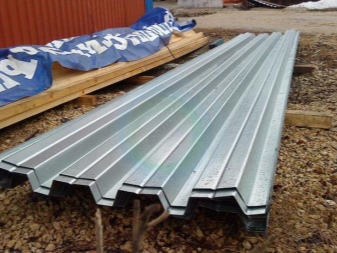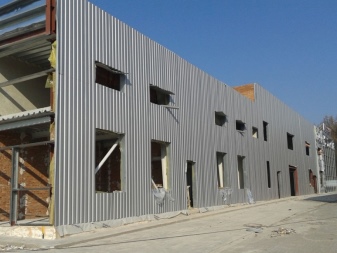All about professional sheets H60

The professional sheet H60, which has a high bearing capacity, is popular in the field of private housing construction. The dimensions and weight, working width and other technical characteristics of this material allow it to provide the structures under construction with high rigidity and strength. It is worth talking in more detail about the use of galvanized corrugated board and H60 sheets with a polymer coating, the rules for their selection, installation.


Specifications
H60 galvanized steel sheet is a popular type of roofing. The established standards imply the release of several types of such products. In accordance with GOST R 52246-2004, galvanized materials obtained by the method of cold rolling are produced. The polymer coated sheet is classified in a different standard. It is standardized in accordance with GOST R 52146-2003.

Marking with the letter H determines the type of material - carrier. Such materials are distinguished by high reliability with a relatively low weight and thickness. The high profile in this case is a significant advantage that distinguishes the structure from wall counterparts. The sheet has an increased level of rigidity, it can be laid horizontally, fastened vertically and diagonally, receiving a coating that can withstand significant loads.
The main difference between the H60 profiled sheet from the H57 and other varieties is the height of the profile. Here it is 60 mm, the shape of the protruding part can be trapezoidal or wavy.

Typical material performance can be described as follows.
- Weight. The weight of 1 m2 of profiled sheet depends on its thickness. With equal dimensions, sheets of 0.7 mm will weigh 8.75 kg / m2, 0.9 mm - 11 kg / m2.
- Dimensions. Usually 2 main parameters are determined - working and full width. For professional sheet H60, these dimensions are different. Working width is 845 mm, total - 902 mm. The length depends on the wishes of the customer, but does not exceed 12 m.
- Thickness. It ranges from 0.7 to 0.9 mm.
- Load bearing capacity. Decking of this brand with a thickness of 0.7 mm can cover spans up to 3-4 m. If there are 2 supports, its bearing capacity will be 323 kg / m2, with 3 - 230 kg / m2. For other options of metal thickness, the indicators will vary.
The calculation of the load on the corrugated board can be done independently, taking into account the expected wind force, the mass of snow, as well as the own weight of the sheet.
Sloped roofs can carry loads more easily, so they can be made with fewer supports and spans.

Applications
The main area of application of the H60 grade profiled sheet is associated with construction. The roofing material is suitable for installation on roofs with complex geometries, without space restrictions. It can be mounted on a roof with spans up to 3-4 meters without installing auxiliary supports. The high load-bearing capacity is complemented by the ease of cutting. You can cut the material into canvases up to 12 m long into any lengths divisible by 1 m.


The following can also be attributed to the spheres of application of the professional sheets of the H60 brand.
- Formwork creation. The material is used in the arrangement of reinforced concrete floors. The formwork is made non-removable, it is preserved after pouring.
- Formation of interfloor floors. Profiled sheet is used in cases where they are made not from a concrete monolith, but from other materials.
- Manufacturing of multi-layer flat roofs. Here the rigid profile becomes the base on top of which the main roofing cake is mounted. Insulation is laid on it, then rolled material. The technology is used in civil and commercial construction, in industrial facilities.
- Formation of stiffness diaphragms. They are essential in the frame structures of buildings. Professional sheet H60 is well suited for these purposes.
- Manufacturing of fences. Sheets are mounted horizontally and vertically and can form temporary or permanent fences. This brand of corrugated board is suitable for installation on a foundation or in a suspended version, with a continuous connection of sheets, it can be part of modular fences.
- Installation of external walls of buildings, structures. Profiled sheet, resistant to wind loads, is used in the manufacture of hangars, warehouse complexes, utility rooms, change houses. It can include additional thermal insulation or be operated without it.




These are the main areas of application for sheets of grade H60. The products have proven themselves well in various areas of construction, are resistant to snow loads and other external influences. They can also be used for other household needs.
How is decking made?
The production of profiled steel sheet is carried out using special industrial equipment that automatically performs most of the tasks. It is here that a corrugated sheet with a certain type of relief is obtained from an ordinary steel sheet. The galvanized metal passes through the shafts of the profiling machine, then enters the guillotine, which is cutting to the required size.


Products of the H60 brand are most often sold in a painted form. The application of the outer decorative layer is carried out by spraying a polymer mixture under pressure or through an electrolysis process. The resulting coating acquires mechanical and corrosion resistance. Coloring is done on 1 or 2 sides of the sheet.

Selection Tips
When planning the purchase of H60 corrugated board, you should pay attention not only to the profitable cost of products. It will be more attractive when purchased without intermediaries, directly from the manufacturer. The main selection criteria will be the following points.
- Compliance of the material with the requirements of GOST. Products manufactured according to technical specifications may have radically different parameters.
- The presence of an additional decorative layer. The polymer coating not only gives the structure additional attractiveness, but also has increased anti-corrosion protection. Ordinary galvanized profiled sheet is most often used to create fences, sheathing sheds.
- External condition. Both zinc coating and polymer coloring should not have traces of delamination, cracks, stains, and other defects. Traces of corrosion along the edge are a reason to refuse to buy a sheet.
- Thickness. It is determined based on the purpose of the structure. The higher the requirements for bearing capacity, the thicker the selected profiled sheet should be.
- The location of the paint layer. If there is a coating, it can be one-sided or two-sided. The first option is used as a roofing material, the second is used to create fences.
The color scheme of the profiled sheet painted with polymer compounds is quite diverse. For the roof, brighter shades are most often chosen, for the fence - neutral, easily washable tones.




Installation features
Most often, the H60 profiled sheet is used as a roof covering. Here, its characteristics and parameters are most in demand. It is imperative to lay the material on a specially prepared base. In this capacity, a crate formed from lumber, most often a bar, acts. It is formed with a certain step between the lags; for the H60 profiled sheet, the maximum dimensions of this clearance are 3 m.



Then the installation continues as follows.
- A waterproofing coating is laid. Depending on the purpose of the roofing structure, this is a plastic film or roofing material. Bituminous materials should not be used in combination with a profiled sheet with a polymer coating - it negatively affects the state of plasticizing substances, destroys them.
- A ventilation gap is formed. It is created using a counter-lattice mounted on top of the waterproofing.
- The professional sheet is laid. It is recommended to use a ridge seal on pitched roofs. The sheets themselves are fastened with self-tapping screws with washers designed specifically for roofing work. It is better to start laying in the direction of the wind, so there will be less difficulties with windage.
- Fixation of roof extensions and other components of the roof. They are installed after the main covering is installed.
Upon completion of the installation, the roof made of corrugated board is ready for use. When used in the construction of fences and other fences, the material is simply attached on supports to the transverse guide lags.














The comment was sent successfully.